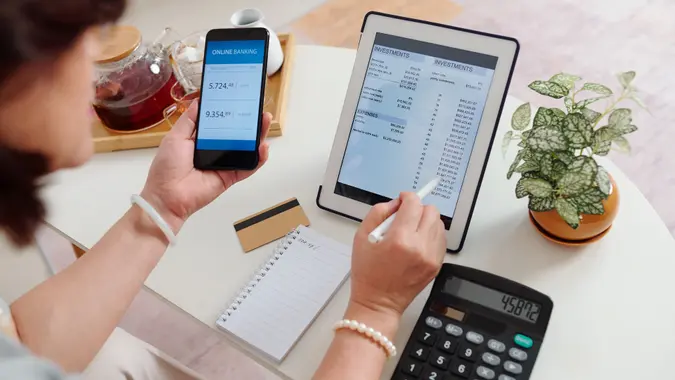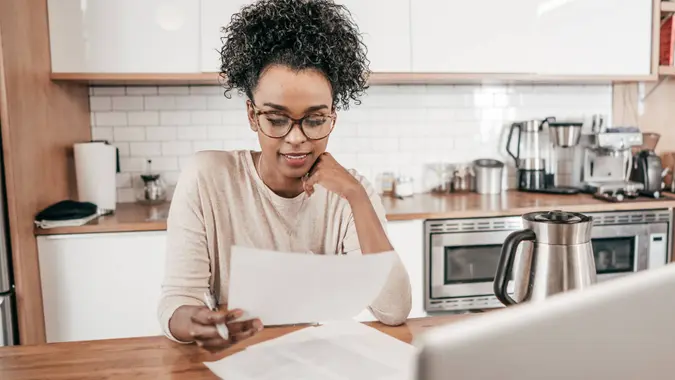Suze Orman: 3 Ways To Help Build Your 3-Month Emergency Savings

Commitment to Our Readers
GOBankingRates' editorial team is committed to bringing you unbiased reviews and information. We use data-driven methodologies to evaluate financial products and services - our reviews and ratings are not influenced by advertisers. You can read more about our editorial guidelines and our products and services review methodology.

20 Years
Helping You Live Richer

Reviewed
by Experts

Trusted by
Millions of Readers
Everyone has experienced unexpected expenses — a parking ticket, a fender bender, an unforeseen medical bill or some other financial emergency. Mishaps will happen, so it’s always recommended to stow away a chunk of money and build an emergency fund.
When things come out of left field — and they will because that’s life — you want to be prepared. Unfortunately, many Americans aren’t ready. According to a recent Empower financial service study, many people would be financially devastated if they experienced the budgetary shock of unplanned expenses.
Here are some more key takeaways from the findings:
- More than 1 in 5 (21%) Americans have no emergency savings — money set aside for unexpected financial events such as job loss, car repairs, home repairs and medical bills.
- Nearly 2 in 5 (37%) couldn’t afford an emergency expense over $400.
- The median emergency savings for Americans is $600
- 1 in 4 (25%) people dipped into emergency savings to cover basic living expenses in the past year
- Paying down debt is a higher priority than saving for an emergency for 57% of Americans
It’s typically advised to have at least three to six months saved that will cover all of the household and living expenses. Knowing where to start can be overwhelming, but Suze Orman, a finance expert and #1 New York Times Bestselling author, outlined in detail how to build a three-month savings.
“I think making three months of living costs your savings goal is beyond fantastic,” she wrote in blog post. “It will be such a great step forward in financial security, and now we know there’s a pretty good chance it may also help you manage your financial stress.”
Here are some ways you should consider downsizing to save on monthly expenses. Any money you save can then be put toward reaching your goals such as having three months’ worth of emergency savings to cover you should the unexpected happen.
Know How Much Your Expenses Are
The first step to saving is knowing how much you need to save. Everyone’s monthly expenses are different, so to understand how much will cover you in an emergency, figure out how much you pay for bills.
Many financial experts recommend having three to six months’ worth of expenses saved in your emergency fund to make sure you don’t spiral into credit card debt if you have to miss work for a while.
“No guessing,” Orman stated. “Or ballparking. Please find some quiet time to tally up not just the rent/mortgage but the food and utilities. And calculate the monthly cost of all your essential insurance premiums: health, home/renters, car.”
Once you determine your monthly expenses, multiply that number by three. “That’s your savings goal,” Orman explained. “Next, divide that sum by 12,” she continued. “For instance, if three months of living costs is $7,500, you would need to save $625 a month to have your 3-month emergency savings within one year.”
She noted if that’s not doable, “divide by 18 to see what you would need to save to meet your goal within a year and a half.”
With Orman’s specific goal of having at least a three-month emergency savings in the bank, you can start saving with intention.
Set Up Savings Account
Set up a savings account once you’ve figured out how much you need to save to have a three-month emergency fund.
“I want you to commit to an automatic deposit into a federally insured bank or credit union savings account,” Orman wrote. “The monthly (or biweekly, or weekly) transfer should be absolutely free to move it from a current account into your new savings account.”
Be sure to find a savings account that doesn’t charge a fee for a minimum balance. You can set up automatic transfers from your checking account to your savings, so your money is out of sight, out of mind and exactly where it needs to be.
Stay on Top of Your Savings
The third and final step to building a three-month emergency fund is to check your savings account once a month. Awareness and vigilance with your finances make even surprising events more palatable for your wallet.
“Give yourself credit for what you have already achieved: every month your account grows, it builds financial security,” Orman said. “And that’s going to help make life less stressful.”
Heather Altamirano contributed to the reporting for this article.
 Written by
Written by  Edited by
Edited by 

























